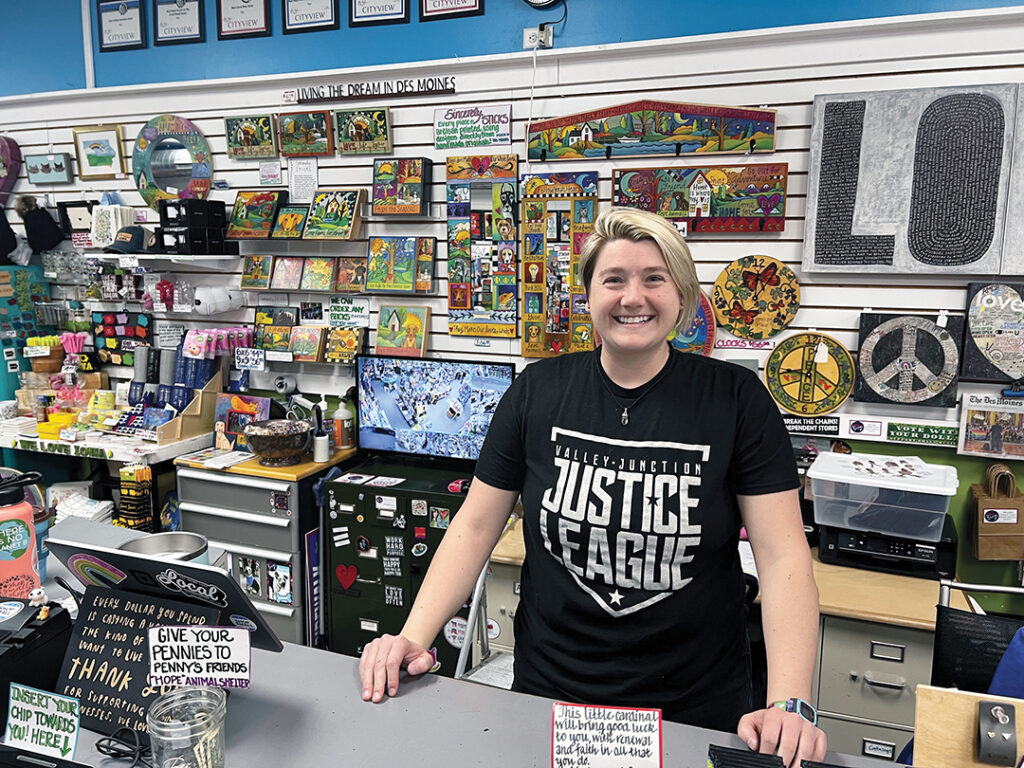How to deal with shoplifting
5/3/2023
Bing’s Owner Val Veiock
On the afternoon of March 23, three women visited West Des Moines’ Historic Valley Junction. They began at Coffee Cats and made their way south. Along the way, they stopped at Bing’s, Sister’s, Memory Lane Antiques and Bozz Prints. While the group made their way around the district, Bing’s Owner Val Veiock was on the hunt.
“They acted really sketchy,” says Veiock.
One moment, the students had things in their hands; the next moment, they were gone. The number of items on the shelves no longer matched the inventory online. And they were carrying reusable tote bags. Veiock wasted no time pulling up her security camera footage.
“Once I found them on the video, I immediately ran down to Coffee Cats to see if they had used a credit card,” she says.
But Coffee Cats had no card information on file. She ran down the street but couldn’t find them. She went in and out of neighboring businesses describing what the suspects looked like. Nothing turned up. However, when she arrived back at her store, Veiock got a text from her friend saying they spotted the group.
“I ran down to the other end of the street and stood in front of their car so they wouldn’t leave,” Veiock says. “And they immediately tried to give me the stuff back. They were trying to hand it to me out the window.”
The Bing’s owner had already called the police.

Robert Hanson is the Loss Prevention Management Department head at Northern Michigan University.
Heightened by the threat of shoplifting
This was not the only instance of shoplifting at Bing’s. Veiock estimates she has caught almost 20 people in the last three years. But what was unique about this time was the number of people shoplifting.
“There was three of them, which I’m not used to,” says Veiock. “Usually, it’s like one person on their own coming in and stealing stuff, but to have three people was really disappointing.”
Veiock says the shoplifters often bring in a reusable tote or canvas bag, or they just use a large purse.
“A lot of times people will go in the deep corners of the store,” Veiock says. “Or they’ll go to the front where I don’t have as good visibility and just wait for me to turn my back.”
After events like this, Veiock and her staff are heightened to the threat of shoplifting. Veiock instructs her staff to engage with customers entering the store. She encourages them to ask how the customers are doing, what they are looking for and what brought them to Valley Junction. She also says employees should offer counterspace to hold customers’ items so they do not walk away without paying for them.
But, by far, Veiock’s biggest preventative measure is her cameras. Veiock spent $5,000 for 10 in-store cameras. She says they are “100% worth the investment.” But, according to Veiock, many of the businesses in Valley Junction don’t make the similar investment.
“People of all ages like to take our stuff without paying for it,” says Veiock. “I don’t think people think about how violating it is to the person they’re stealing from. No matter how many times it happens to me — and I know it happens more than I’m catching people, obviously — it doesn’t ever get easier.
“At the end of the day, I know those girls wouldn’t have stolen from me on the street personally. But it’s the exact same thing when you come in here. I own all this merchandise you just stole from me personally. This is what I do to make my living.”
Online program designed to address loss threats
Robert Hanson is the Loss Prevention Management Department head at Northern Michigan University. The program started in 2007 and is geared toward loss prevention professionals who have management skills and positions but need a degree to give them credentials. In conjunction with the National Retail Federation and experts in the field, Northern was able to create an online program designed for full-time employees. However, the loss threats at the beginning of the program are completely different from the threats of today.
“When we started back in 2007, credit card fraud was unheard of,” Hanson says. “The idea of organized retail theft, where gangs of people come in and steal…merchandise out of stores, (was) unheard of.”
According to Hanson, there are many kinds of loss. The type of loss a business might experience largely depends on the business itself. The most obvious one is people coming into a store and stealing, but that might be the least of a small business owner’s concerns. Sometimes paperwork is not completed properly, sometimes a store gives credit for returned merchandise that was stolen, and sometimes even bigger legal issues arise.
“The private sector is open to all kinds of lawsuits,” Hanson says. “And, in fact, in some places, it’s slip and fall. Fake slip and fall accidents are a cottage industry. So, people will come in as a team and pour some liquid on the floor, then their confederate comes along and pretends to fall down.”
Hanson says a well-managed business will have a plan for an internal investigation to avoid these allegations.
“The first thing is to identify what are the areas where you could sustain loss. And then you need to think about what you can do to mitigate that loss… It would depend upon an assessment of what you could actually afford to do because, if it is more expensive to do the prevention than to suffer the loss, the prevention isn’t worth it.”
Hy-Vee grocery stores made news when they began rolling out armed security guards that Hanson describes as “people dressed almost like SWAT team members.”
To determine the effectiveness of loss prevention strategies, each company needs a metric to track its return on investment. Hanson suggests managers ask whether the expense involved reduces exposure to loss and if it impacts the bottom line.
But there is another thing to consider: customer experience.
“Myself, when I go into a store, and I see that kind of armed protection, what kind of store am I going into?” Hanson asks. “It would be very interesting to see what the customer perception is.”
One loss prevention strategy that does not negatively affect customer experience involves internal cameras. Placing a monitor at the entrance of the store signals to customers that they see them. And, if someone is coming into the store to steal, they have a picture of them walking in. The price of internal camera systems has significantly declined in recent years. Hanson says the investment might be worth it to avoid slip-and-fall lawsuits.
Many resources exist for small business owners to better prevent loss. Hanson suggests reaching out to local associations, federations and chambers of commerce to connect with those who have more knowledge and experience.

Jacque Brittain currently serves as the editorial director of Loss Prevention Magazine, the official loss prevention industry publication.
Jacque Brittain
Jacque Brittain currently serves as the editorial director of Loss Prevention Magazine, the official loss prevention industry publication. Before his current role, Brittain spent years in the loss prevention industry. In collaboration with the Loss Prevention Foundation, he helped develop the internationally sanctioned LP credentials LPQualified and LPCertified. The magazine gathers editorial content from staff and loss prevention experts bi-monthly.
“We will tie in things that are important to every retail store,” says Brittain.
According to Brittain, the goal of loss prevention is to enhance the profitability of a company. In other words, you cannot sell stuff that’s stolen.
“Opportunity plus desire equals theft,” says Brittain. But theft does not always come in the form of a shoplifter.
Internal loss, loss caused by an employee, is a huge threat to a business. Plus, employees are the ones who have the most opportunity. Brittain suggests business owners recognize the opportunities employees have and mitigate them.
Another example is assumed deliveries. Brittain says business owners should check their merchandise shipments for accurate counts. A company he previously worked for lost $3,000 a month on empty boxes of chewing gum.
If a business does catch a shoplifter in the act, Brittain says there is a five-step apprehension process to confirm the crime:
1. Did you see the suspect enter the area where the product is stored?
2. Did you see the suspect select the merchandise?
3. Did the suspect attempt to conceal the merchandise?
4. Did you maintain observation from the area toward the exit?
5. Did the suspect leave the store without paying?
Without these five steps, Brittain says businesses create a liability. Business employees should never use excessive force, he says, but can detain a suspect if they are sure of it. A business owner or employee should also contact law enforcement.
Brittain says business owners should never retrieve the merchandise themselves.
“There’s nothing in a store that’s worth someone getting hurt,” he says.
“The worst thing to do is leave the store, even if a business owner is sure of the crime. Shoplifters could have a weapon. If chasing them out of the store means chasing them into the street and someone gets hurt, the business becomes liable.”
Brittain says if a shoplifter is chased into the street and dies, the business owner has a murder investigation on his or her hands.
“You should never chase people out of the store,” Brittain says. “It doesn’t pay dividends.” ♦





















